 When we think about domestic violence, by default most of us picture a man as the perpetrator and a woman as the victim. Indeed, this image has been largely programmed into our minds by cultural stereotypes of women as the “weaker sex.” While the majority of reported instances of DV are committed against women, the actual numbers suggest the imbalance isn’t as broad as we think. (According to the NCADV, 1 in 3 women are victims of some form of physical violence by a partner, compared to 1 in 4 men.)
When we think about domestic violence, by default most of us picture a man as the perpetrator and a woman as the victim. Indeed, this image has been largely programmed into our minds by cultural stereotypes of women as the “weaker sex.” While the majority of reported instances of DV are committed against women, the actual numbers suggest the imbalance isn’t as broad as we think. (According to the NCADV, 1 in 3 women are victims of some form of physical violence by a partner, compared to 1 in 4 men.)
However, another variable—once virtually ignored—may be playing into these statistics in a greater way than anyone had previously realized. Recent research shows that domestic violence within same-sex relationships may actually be more prevalent than in heterosexual relationships. Perhaps even more surprising: Female same-sex relationships may suffer higher rates of violence than their male counterparts.en, the actual numbers suggest the imbalance isn’t as broad as we think. (According to the NCADV, 1 in 3 women are victims of some form of physical violence by a partner, compared to 1 in 4 men.)
However, another variable—once virtually ignored—may be playing into these statistics in a greater way than anyone had previously realized. Recent research shows that domestic violence within same-sex relationships may actually be more prevalent than in heterosexual relationships. Perhaps even more surprising: Female same-sex relationships may suffer higher rates of violence than their male counterparts.
 “Truth is stranger than fiction, but it is because fiction is obliged to stick to possibilities; truth isn’t.” –Mark Twain
“Truth is stranger than fiction, but it is because fiction is obliged to stick to possibilities; truth isn’t.” –Mark Twain Los Angeles Criminal Defense Attorney Blog
Los Angeles Criminal Defense Attorney Blog







